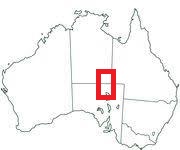
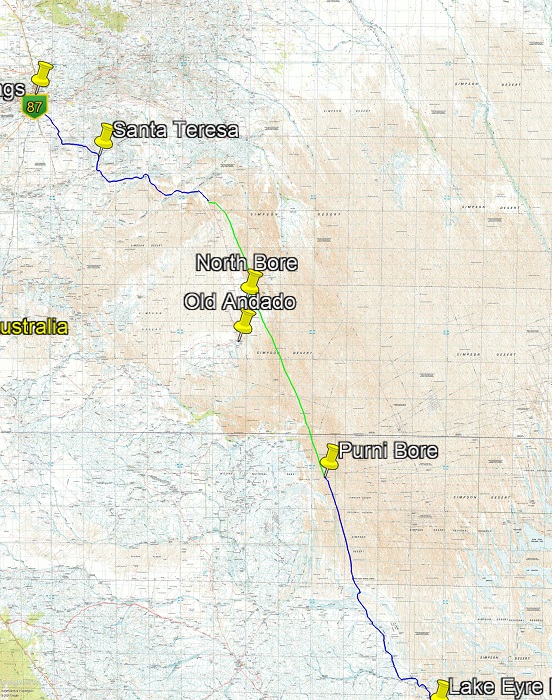
Movie stage IX
| start date | activity | place | from - to | days | km | km/ day | comment |
| 24.07 | desert cart | Old Andado Track | Allambie Station - Desert Edge | 3 | 97 | 32 | 4WD track |
| 27.07 | desert cart | Simpson Desert | Desert Edge - Purni Bore | 10 | 233 | 24 | Off-track |
| 6.08 | desert cart | Simpson Desert | Purni Bore - Macumba River | 4 | 96 | 24 | Off-track |
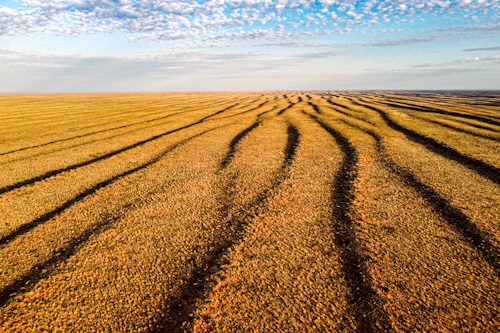
I was following the Old Andado Track and the hills were slowly disappearing, the trees were ending, and the dunes were beginning. I got to the edge of the desert. Here I turned into the wilderness and immediately a pleasant surprise, because I had a firm ground, little vegetation, just a quick and pleasant transition. It would be if…
On the very first day since I went off-track, I made a massive discovery - some of my food was lost somewhere. I did not have breakfasts, soups and desserts, a total of 10,000 calories (later it turned out that the box was missed when we moved it from the hostel to the car, which brought me a cart and gear 114km from Alice Springs, exactly where I left my bike).
 On the second day I got a flat tire, and on the third the spoke broke, the USB cable in solar panel broke, the excel crashed on phone where I wrote down all the information and I lost the spoon (since then, for a few weeks I was eating with a trowel). On the fourth day a repetition of the entertainment - flat tire, although I was looking for those little strong sticks sticking out of the ground (witch's hand), and the next day a broken spoke regardless that in Alice Springs I took both wheels to a professional repair shop. On the seventh, I took out a piece of wood stick out of the tire, and on the ninth, another spoke broke and a torn cord in the gaiters. The next day the case of the watch broke and the cart flipped, after the night encounter of an aggressive snake and a lost sandal. On the 12th day, the culminating cart flipped and another spoke broke. I don't know why nothing bad happened in the last two days.
On the second day I got a flat tire, and on the third the spoke broke, the USB cable in solar panel broke, the excel crashed on phone where I wrote down all the information and I lost the spoon (since then, for a few weeks I was eating with a trowel). On the fourth day a repetition of the entertainment - flat tire, although I was looking for those little strong sticks sticking out of the ground (witch's hand), and the next day a broken spoke regardless that in Alice Springs I took both wheels to a professional repair shop. On the seventh, I took out a piece of wood stick out of the tire, and on the ninth, another spoke broke and a torn cord in the gaiters. The next day the case of the watch broke and the cart flipped, after the night encounter of an aggressive snake and a lost sandal. On the 12th day, the culminating cart flipped and another spoke broke. I don't know why nothing bad happened in the last two days.
 Is it maybe something positive after these numerous breakdowns and time spent on repairs?
Nature. Every morning before sunrise and in the evenings after sunset, there were no sounds, perfect silence. No wind, no insects, anything. Incredible!
Is it maybe something positive after these numerous breakdowns and time spent on repairs?
Nature. Every morning before sunrise and in the evenings after sunset, there were no sounds, perfect silence. No wind, no insects, anything. Incredible!
Birds were also interesting - beautiful, green and tiny, they flew in small groups, but once I saw them (and heard) in thousands - I thought it was a plane somewhere nearby, and they were clouds of flapping wings, something indescribable.
I was even more intrigued by the young birds that lived on the ground, not in trees. When I walked they usually shot up a meter from me like a slingshot, but very often such an individual could not fly yet, so he ran away and was hiding behind the spinifex. Dozens of times they ran as hard as they could in their legs and finally a flight - I am convinced that it was their first flight in their life.
 Simpson was completely different from Gibson or Little Sandy. First of all, more predictable - with one exception of the disappearance of the dunes and the appearance of a rocky canyon. The sand dunes were all pallel, some smaller some larger, some stretched several dozen kilometers, others only a few. And only during the first three and the last day the distance between the dunes were large, and the terrain between them was relatively flat and devoid of lush vegetation. Unfortunately, the remaining 10 days were a tough, especially in connection with equipment failures and hunger (I had spare spokes and tubes so I solved the breakdowns, and I took a little more food than on the Gibson, so it was bad but not tragic). Terrain was muldy with bushes or spinifex, and I learned that usually the best ground was on the eastern side of the large dunes, but the dunes split, ended, rose etc, so you had to fight for the terrain from the start. There was a paradox - the more kilometers I traveled during the day, the less tired I was, because it meant a better pace, that is, less pulling the cart by force.
Simpson was completely different from Gibson or Little Sandy. First of all, more predictable - with one exception of the disappearance of the dunes and the appearance of a rocky canyon. The sand dunes were all pallel, some smaller some larger, some stretched several dozen kilometers, others only a few. And only during the first three and the last day the distance between the dunes were large, and the terrain between them was relatively flat and devoid of lush vegetation. Unfortunately, the remaining 10 days were a tough, especially in connection with equipment failures and hunger (I had spare spokes and tubes so I solved the breakdowns, and I took a little more food than on the Gibson, so it was bad but not tragic). Terrain was muldy with bushes or spinifex, and I learned that usually the best ground was on the eastern side of the large dunes, but the dunes split, ended, rose etc, so you had to fight for the terrain from the start. There was a paradox - the more kilometers I traveled during the day, the less tired I was, because it meant a better pace, that is, less pulling the cart by force.
I was also surprised by the changeability of the weather - it was actually good as during the day it was neither cold nor hot, but in the morning I had -3 degrees, and a few days later it was over 20. Two days without sun I drank more than 20 liters of water (humidity).
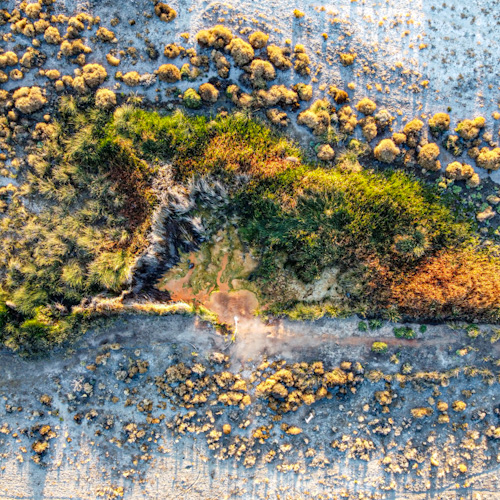
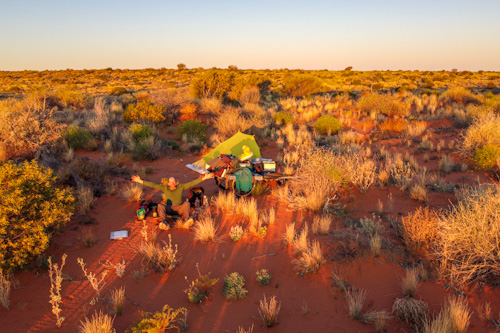

But finally, except for the first three days before I reached the edge of the desert along the road, after 14 days and 329 km I reached the Macumba River. This is Arunta's southern border, and the terrain has changed like a knife cut. I estimate that I crossed about a hundred dunes, drank a little less liters of water, and I met people at two points. I had a lot of water so the stress was much less than in previous deserts. When I saw the first trees and a cattle fence, I screamed triumphantly - more relief than pride, but the satisfaction remained. Despite the fact that it was the end of the desert, there were over 400km to the nearest shop on my nearest further route :)
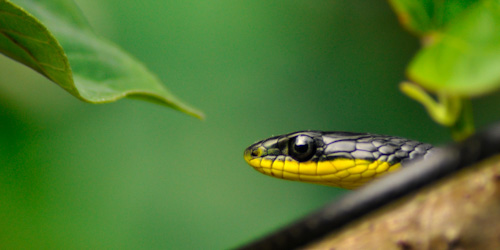
Walking through all the sandy deserts in my life I have never encountered a snake. For a fairly simple reason - approaching on my legs, the reptile will sense the smell or vibration of the ground much earlier and will have time to hide. The exception is a Death Adder - this species does not go out of the way, it waits curled up in hiding (e.g. in spinifex) and imitates the buzzing of an insect with its tail. I would never like to meet him in nature.
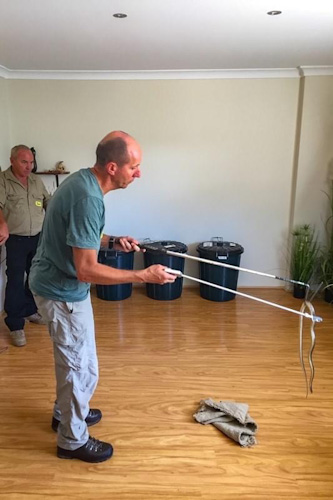
So you can easily imagine my surprise while climbing the dune out of the corner of my eye I saw something moving - I looked, and here a small snake is crawling towards me with a raised and strangely flattened head. It was a signal of attack readiness. Two instincts acted immediately - the first was looking for the camera with my hands, and the second ordered me to freeze with my legs, but as the Desert Banded snake was still approaching enough to make an effective strike, no more than a meter from me, I backed up on my own. Then the beautiful beast took a basic apperance and slipped into the nearest clump of spinifex.
What to do if we get bitten? In Australia the answer is quite simple - put on a pressure bandage and do not move the bitten limb for any reasons. This will help with even the most poisonous taipans.
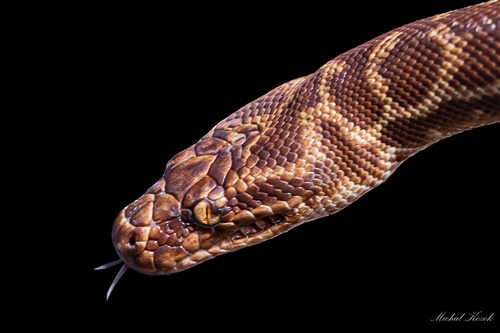
It is said that up to 100,000 people worldwide die from snake bites a year, and in Australia alone, on average, there are only 2-3 deaths annually. So it does not matter that we have the most poisonous snakes in the world - they are difficult to find in areas far from civilization, and if we are unlucky, it is easy to prevent the worst.